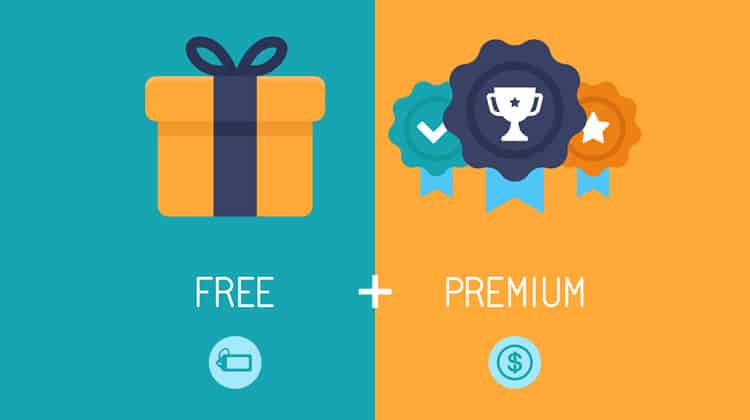
The word “free” is often music to our ears. Free trial, free download, free music, we will take it all as long as there are no strings attached. This tangled web of strings, however, is what puts the sceptic in us, and we start to believe that nothing is free.
Mobile app strategies left free trials in the dust and created a new tactic: the freemium. A crossbreed of “free” and “premium”, the freemium tactic encompasses (you guessed it) both free and premium services. This may seem like a great idea at first, but lest we remember: there is no such thing as a free lunch. Not to mention, freemiums can also damage your mobile app’s UX.

So, why are apps here in the first place? Apps are here to solve a need(s) and make us happy, excite us and motivate us. Ultimately, apps are a business, and what do companies need to stay alive? Money. This can entail any money-making tactic, from in-app ads, payment when downloading, subscriptions, and … freemiums.
Is It Really Free?
A freemium and a free trial are not one in the same. The concept of a free trial is an oldie, but not always a goodie. Trying something out before you buy seems like the greatest thing since sliced bread, but over time, mobile users have been groomed to sniff out a scam, and they know that there are often contingencies linked with a free trial.

Limited freemiums can also have certain restrictions, such as limiting services that a user will receive in the free account. Alternatively, these restrictions could be seen through abolishing all commercialisation if you upgrade to a premium account.
Regardless of the type of freemium (or free trial) that you are employing, there will be consequences affecting your onboarding process, user retention, and churn rates. So let us dive right in and assess the positives and negatives of freemiums and how you can implement the best approach into your app’s strategy.
Your App Has Been Launched
In the App Store/Google Play, your app is listed as free, even if it is 100% freemium. Well done, you got users to download your “free” app, but now let us hope they get past the onboarding process that comes with your freemium experience.

Many apps (free, freemium, and paid) require a painless sign-up process that entails inputting your email and name, or even more uncomplicated, connecting to the app via one of your social media accounts. While some users may even think this is too much personal info to be handing over, most people will see it as a quick course of action needed to join.
Blinkist, although technically a “free forever” app, is still based on the freemium model because it limits what users can access with their Free Account (one Blinkist-chosen book summary per day). Otherwise, the Premium Account is a whopping $79.99.
The onboarding UX is seamless, enticing users to download the app, sign up, and probably return a few times due to the novelty. It is also a fantastic choice to allow the user to sign up and connect via a Facebook account quickly. However, there are still going to be hurdles because the user is not able to enjoy the non-fiction literature of his/her choosing. Ultimately, the user will have to choose to continue with the daily surprise of Blinkist choosing for them, upgrade to Premium, or abandon the app entirely.
While the app succeeded in piquing user interest and getting them to download it (and inevitably getting a fair amount of users to upgrade to Premium), this can still be a tricky choice. Why? Because only two options are available: a) the free version does not give enough of a “worth it” element for users to stay engaged in the app, and b) the premium account is quite a steep price.
Should I Pay Or Should I Go?
Perhaps it is clear from the get-go that an app is limited based on whether or not payment is requested (Sign Up For Free vs Subscribe Now). In this case, many users will be deterred from signing up entirely because they know that they will not receive the full benefits of the app.
A good example is Headspace, which clearly indicates that there is a paid option (by mentioning the opposite, the “free” option). Users know that based on this sign-up process, there will be limitations within the Free Account, and to unlock the full Headspace Library, a user must subscribe. There is a decent amount of free sessions available to get started in various categories (Mindful Eating, Managing Anxiety, Sadness, Anger and the like), but without a subscription, it is impossible to progress through a category.
For some users, a quick taster of these sessions is sufficient to get the mindfulness ball rolling. For others, the beautiful UI of Headspace is convincing enough that subscribing will be the best choice.
Need More Storage Space?
In some apps, the product’s infrastructure and the app’s UI are excellent enough that most users will not “need” to pay for extra costs. However, depending on increased usage or need, longtime customers might end up becoming premium users because they want to, and not because they were “pressured”.
Some apps, like Evernote, are 100% free, but to upgrade storage space or add additional minor features, users must pay.
However mobile users are always on the lookout to avoid being scammed. So any small thing can set a user off, resulting in leaving the app forever. For example, many apps, although technically free, still have pesky in-app messaging that would drive anyone crazy. If you are bombarding users with in-app messaging and pop-ups as soon as they begin a free trial, or as soon as they sign up and you want them to upgrade, this is the wrong time.
The Freemium Of All Freemiums
Pay money and get rid of any advertisements! This is a classic tactic for convincing users to pay money, and plenty of apps, like Spotify, provide the straightforward process of paying a monthly fee to sign up and/or upgrade to a Premium account.
Here, you can still listen to loads of music, but essentially Spotify controls your playback:
- You cannot repeat songs (unless they are on one of the 15 Spotify playlists created for you by algorithms)
- You are limited to the number of songs you can skip on a playlist (again, limited to the 15 Spotify-created playlists)
- You definitely have to listen to advertisements
On other apps, like Duolingo, you do have full access to everything on the app – if you are learning Dutch, you can indeed access all of the levels. Even though at the end of every lesson there is an ad that pops up, Duolingo remains utterly transparent with users that these ads exist to support free education. However, is users want, they can still opt to upgrade to Premium and get rid of ads forever.
For the majority of users, there will be an appealing solution available. The fact that Duolingo creates an honest and authentic user experience, they are able to amass more and more users for free language learning successfully. The real beauty lies in monitoring the UX. In the end, you will see what success in your app is and what ultimately does not succeed in your efforts.
What Are Your Users Doing In The Free Account?
When new users enter your app, presumably they are going straight to the free features, but are they also poking around at the paid/locked features? What about returning/loyal users – what are they doing?

If you want to understand how your users are navigating your app, the best tools to analyse would be user flows and user recordings. These features help you understand your users better via their behaviour and their journeys and enables you to optimise your app based on their needs and wants. Your app will stay fresh for old users, who will subsequently recommend your app as well.
At The End Of The Day
Let us recap. There are pros and cons to freemiums, and certain apps are utilising specific freemium tactics to achieve their goals. However, if not used smartly, freemiums can be perilous to your mobile app and its future.
Also, maybe, just maybe, you will realise that freemiums are not your users’ jam. Alternatively, maybe they are. However, to receive a bonafide answer, testing and tracking your freemium plan(s) with user behaviour analytics is a solid way to understand the effects. This is how you will be sure to feed your users’ app-etites.
Want to learn more?
If you’re interested in the managerial and strategic aspects of UX, then consider to take the online course on UX Management and Strategy. If, on the other hand, you want to brush up on the basics of UX and Usability, then consider to take the online course on User Experience (or another design topic). Good luck on your learning journey!
(Lead image: Depositphotos)
